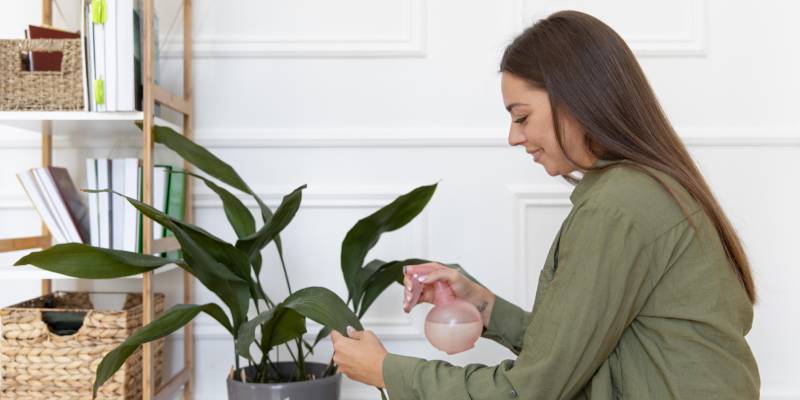Transforming your living space into a healthier environment is easier than you might think. Incorporating air-purifying plants into your home not only adds a touch of nature to your decor but also helps cleanse the air of harmful pollutants.
Here’s a guide to the top 10 essential indoor air-purifying plants that can enhance the air quality in your home, making it fresher and healthier.
Top 10 Air Purifying Plants to Enhance Health and Refresh Your Space
Let’s explore the top 10 air-purifying plants that can elevate your health and revitalize your space.
Broadleaf Lady Palm (Rhapis excelsa)
The Broadleaf Lady Palm is a standout choice for improving indoor air quality. Known for its ability to filter out pollutants like nitrogen oxide, toluene, benzene, xylene, and formaldehyde, this plant can grow up to six feet tall, making it perfect for filling corners in larger rooms. As one of the most effective Indoor Air-Purifying Plants, its lush, feathery fronds add a touch of tropical elegance to any space.
Specialty:
- Air Purification: Filters out a wide range of pollutants, including formaldehyde and benzene.
- Size: Can grow up to six feet tall, ideal for larger spaces.
- Appearance: Lush, feathery fronds that enhance the aesthetic of any room.
- Care: Prefers moderate watering and indirect light.
Philodendron
Philodendrons are classic indoor plants with a variety of shapes and sizes, making them versatile for any home decor. As Indoor Air-Purifying Plants, they are especially effective at removing formaldehyde, a common pollutant found in cleaning products and other household items. With their adaptable nature, Philodendrons are a great option for enhancing air quality throughout your home.
Specialty:
- Air Purification: Removes formaldehyde from the air.
- Versatility: Available in various shapes and sizes to suit any decor.
- Low Maintenance: Thrives in low to bright indirect light.
- Adaptability: Can be placed in different areas of the home.
Aloe Vera
Aloe Vera is celebrated not only for its soothing gel but also for its air-purifying qualities. It efficiently reduces formaldehyde and benzene levels in indoor air. As one of the easiest Indoor Air-Purifying Plants to care for, it thrives with minimal attention in bright light, making it an excellent choice for various indoor settings. Additionally, its gel can be used for skincare, adding to its multifunctional appeal.
Specialty:
- Air Purification: Reduces formaldehyde and benzene.
- Multi-Purpose: The gel can be used for skincare.
- Low Maintenance: Requires minimal watering and bright light.
- Compact Size: Ideal for small spaces or as a desk plant.
Lemon Button Fern (Nephrolepis Cordifolia)
The Lemon Button Fern is a beautiful, delicate plant that offers robust air-purifying benefits. It effectively addresses pollutants such as xylene, toluene, and formaldehyde, which can contribute to headaches and other health issues. Among Indoor Air-Purifying Plants, its elegant, feathery foliage also enhances the aesthetic of your living space.
Specialty:
- Air Purification: Handles harmful chemicals like xylene, toluene, and formaldehyde.
- Compact: Perfect for small spaces.
- Appearance: Delicate, feathery fronds add elegance to your decor.
- Care: Thrives in moderate humidity and indirect light.
Peace Lily (Spathiphyllum ‘Mauna Loa’)
The Peace Lily is known for its striking white blooms and ability to filter out harmful gases like carbon monoxide and formaldehyde. This popular member of the Indoor Air-Purifying Plants category not only adds a touch of beauty to your home but also significantly improves indoor air quality. It’s important to note, however, that the Peace Lily can be mildly toxic if ingested, so care should be taken around pets and children.
Specialty:
- Air Purification: Removes carbon monoxide and formaldehyde.
- Decorative: Features beautiful white blooms.
- Moderate Care: Requires regular watering and indirect light.
- Toxicity: Can be harmful to pets and humans if ingested.
Weeping Fig (Ficus benjamina)
The Weeping Fig is a popular choice for improving indoor air quality, praised for its ability to combat pollutants such as xylene and formaldehyde. As one of the more elegant Indoor Air-Purifying Plants, it requires regular watering and thrives in indirect light, making it a versatile option for many indoor environments. Its cascading foliage adds a graceful touch to your decor.
Specialty:
- Air Purification: Filters out xylene and formaldehyde.
- Graceful Appearance: Cascading foliage enhances any space.
- Care Requirements: Needs regular watering and indirect light.
- Versatility: Suitable for various indoor environments.
English Ivy (Hedera helix)
English Ivy is a low-maintenance plant that excels at removing toxic chemicals from the air. Its trailing vines are perfect for hanging baskets or climbing trellises. English Ivy’s ability to eliminate pollutants and its minimal care requirements make it a great choice for enhancing air quality with little effort.
Specialty:
- Air Purification: Removes toxic chemicals like formaldehyde.
- Versatile Placement: Ideal for hanging baskets or trellises.
- Low Maintenance: Requires minimal care.
- Adaptable: Grows well in various indoor conditions.
Dragon Tree (Dracaena marginata)
The Dragon Tree, with its striking spiky leaves, is both an attractive and effective air purifier. It helps filter out pollutants like xylene, toluene, benzene, and formaldehyde. Its unique appearance and ability to improve air quality make it a popular choice for adding a splash of colour to your home.
Specialty:
- Air Purification: Effective against xylene, toluene, benzene, and formaldehyde.
- Unique Appearance: Spiky leaves with green or purple hues.
- Easy Care: Thrives with minimal watering and indirect light.
- Decorative: Adds colour and interest to any room.
Chinese Evergreen (Aglaonema modestum)
The Chinese Evergreen is a colourful and resilient plant that thrives even in low-light conditions. It effectively purifies the air by removing toxins, making it ideal for small apartments or less brightly lit rooms. This adaptable plant stands out among Indoor Air-Purifying Plants due to its attractive foliage and minimal care requirements, making it a practical addition to any home.
Specialty:
- Air Purification: Removes toxins from the air.
- Low Light Tolerance: Perfect for dimly lit spaces.
- Resilient: Thrives with minimal care.
- Decorative: Attractive, colourful foliage.
Spider Plant
The Spider Plant is a favourite among indoor gardeners for its ease of care and air-purifying abilities. It’s effective at neutralizing benzene and formaldehyde and adds a lively touch with its arching, variegated leaves. The Spider Plant is particularly well-suited for beginners due to its low maintenance needs.
Specialty:
- Air Purification: Neutralizes benzene and formaldehyde.
- Low Maintenance: Ideal for beginners.
- Decorative: Features arching, and variegated leaves.
- Resilient: Tolerates a variety of indoor conditions.
Which Air-Purifying Plants to Choose for My Space?
Selecting the right air-purifying plants depends on various factors such as lighting conditions, space availability, and your lifestyle. Here are some tips to help you choose:
- For Low Light Conditions: If your space lacks natural light, opt for plants like the Chinese Evergreen or Philodendron. These plants thrive in low-light environments and still offer significant air-purifying benefits.
- For Bright, Sunny Spaces: Plants such as Aloe Vera and Spider Plant thrive in bright conditions and will add a vibrant touch to your well-lit rooms.
- For Small Spaces: Compact plants like English Ivy and Lemon Button Fern are perfect for small apartments or offices. Their minimal size and maintenance requirements make them ideal for limited spaces.
- For High Humidity Areas: The Weeping Fig and Peace Lily are great choices for areas with higher humidity, such as bathrooms or kitchens. They help maintain air quality while thriving in these conditions.
- For Aesthetic Appeal: If you’re looking for plants that not only purify the air but also enhance your decor, consider the Dragon Tree or Broadleaf Lady Palm. These plants add a unique visual element to your home.
Conclusion
Incorporating these top 10 indoor air-purifying plants into your home is an effective way to enhance air quality while adding natural beauty to your space. From the elegant Broadleaf Lady Palm to the resilient Spider Plant, each of these plants offers unique benefits that can help create a healthier living environment. Choose the plants that best fit your space and lifestyle to enjoy fresher, cleaner air and a more vibrant home.
If you’re looking for a new home to start fresh with these plants, consider exploring Peninsula Infra, renowned for offering some of the best villas in Bangalore. Discover your perfect living space with Peninsula Infra and create a healthier, more beautiful home environment.
Contact us today to find out more about our villas and how you can make your next move to a space where you can truly thrive. Explore our villa options and get in touch!
FAQs
How do air-purifying plants work?
Air-purifying plants improve indoor air quality by absorbing pollutants through their leaves and roots. They can neutralize harmful chemicals like formaldehyde, benzene, and xylene, and convert them into less harmful substances.
How many air-purifying plants do I need?
The number of plants needed depends on the size of your space and the level of air pollution. Generally, having one plant per 100 square feet can help maintain cleaner air. However, adding more plants can provide additional benefits.
Are these plants safe for pets?
Some air-purifying plants, like the Peace Lily and Aloe Vera, can be toxic to pets if ingested. Always ensure that plants are placed out of reach of pets or choose pet-safe alternatives if you have animals in your home.
How often should I water air-purifying plants?
Watering needs vary by plant species. Most air-purifying plants prefer to dry out between waterings. It’s essential to follow specific care instructions for each plant to avoid overwatering or underwatering.
Can air-purifying plants help with allergies?
Yes, some air-purifying plants can help reduce allergens in the air by removing airborne pollutants and increasing humidity. However, they should be used as a supplementary measure alongside other allergy management strategies.
How do I care for air-purifying plants?
Care requirements vary by plant, but common needs include appropriate lighting, regular watering, and occasional feeding. Ensure you understand the specific needs of each plant to keep them healthy and effective in purifying the air.




